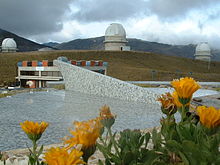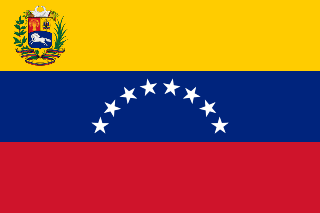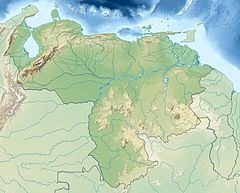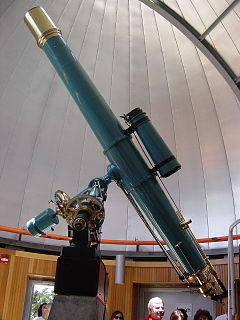
The Apache Point Observatory is an astronomical observatory located in the Sacramento Mountains in Sunspot, New Mexico, United States, approximately 18 miles (29 km) south of Cloudcroft. The observatory is operated by New Mexico State University (NMSU) and owned by the Astrophysical Research Consortium (ARC). Access to the telescopes and buildings is private and restricted.
Catalina Sky Survey is an astronomical survey to discover comets and asteroids. It is conducted at the Steward Observatory's Catalina Station, located near Tucson, Arizona, in the United States.

Stardome Observatory is a public astronomical observatory situated in Cornwall Park in New Zealand's largest city, Auckland.

The Galileo National Telescope, is a 3.58-meter Italian telescope, located at the Roque de los Muchachos Observatory on the island of La Palma in the Canary Islands, Spain. The TNG is operated by the "Fundación Galileo Galilei, Fundación Canaria", a non-profit institution, on behalf of the Italian National Institute of Astrophysics (INAF). The telescope saw first light in 1998 and is named after the Italian Renaissance astronomer Galileo Galilei.

The Beijing Schmidt CCD Asteroid Program (SCAP) was a astronomical survey to search for near-Earth objects. It was conducted during the 1990s, at the Xinglong Station in the Yanshan mountains of China's Hebei province and resulted in the discovery of more than a thousand numbered minor planets.

Siding Spring Observatory near Coonabarabran, New South Wales, Australia, part of the Research School of Astronomy & Astrophysics (RSAA) at the Australian National University (ANU), incorporates the Anglo-Australian Telescope along with a collection of other telescopes owned by the Australian National University, the University of New South Wales, and other institutions. The observatory is situated 1,165 metres (3,822 ft) above sea level in the Warrumbungle National Park on Mount Woorat, also known as Siding Spring Mountain. Siding Spring Observatory is owned by the Australian National University (ANU) and is part of the Mount Stromlo and Siding Spring Observatories research school.

Bassano Bresciano is a comune in the province of Brescia, in Lombardy. As of 2011 Bassano Bresciano had a population of 2,237.
The Črni Vrh Observatory is an astronomical observatory located in western Slovenia, close to the settlement of Črni Vrh, near the town of Idrija. The current observatory was built in 1985 and stands at an elevation of 730 metres (2,400 ft). Much of the construction was done by volunteers.

Teide Observatory, IAU code 954, is an astronomical observatory on Mount Teide at 2,390 metres (7,840 ft), located on Tenerife, Spain. It is operated by the Instituto de Astrofísica de Canarias since its inauguration in 1964. It became one of the first major international observatories, attracting telescopes from different countries around the world because of the good astronomical seeing conditions. Later the emphasis for optical telescopes shifted more towards Roque de los Muchachos Observatory on La Palma.

The Optical Ground Station (OGS) telescope, installed in the Teide Observatory, has been built by Carl Zeiss. The telescope is ESA's Optical Ground Station forming a part of the Artemis experiment and is operated by the IAC and Ataman Science S.L.U.
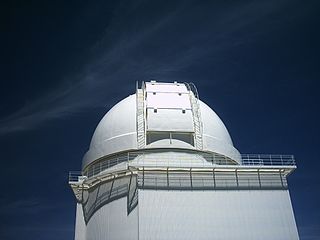
The Calar Alto Observatory is an astronomical observatory located in Almería province in Spain on Calar Alto, a 2,168-meter-high (7,113 ft) mountain in the Sierra de Los Filabres range.

The Vainu Bappu Observatory is an astronomical observatory owned and operated by the Indian Institute of Astrophysics. It is located at Kavalur in the Javadi Hills, near Vaniyambadi in Vellore district in the Indian state of Tamil Nadu. It is 200 km south-west of Chennai and 175 km south-east of Bangalore.

The Kevola Observatory is located in Kevola in Paimio in South-Western Finland, some 35 km east from the city of Turku. The observatory is currently owned by Turun Ursa ry, a local astronomical association operating in Turku area. The buildings of the observatory include an observatory dome, a zenith observatory, and a house for recording observations.

Rozhen Observatory, also known as the Bulgarian National Astronomical Observatory, is an astronomical observatory, located in the Smolyan Province, 90 kilometers south of the city of Plovdiv, Bulgaria. The nearest town, Chepelare, is 15 kilometers away. The observatory is owned and operated by the Institute of Astronomy of the Bulgarian Academy of Sciences (BAS). It was officially opened on 13 March 1981, almost 20 years after Bogomil Kovachev – a professor of astronomy at BAS, known as its founder – had started working towards that goal. The Observatory is the largest in Southeastern Europe and has an active team of about 50 astronomers. It is the principal center for astronomical research in Bulgaria. The minor planet 6267 Rozhen, was discovered at, and named after the observatory.

The National Astronomical Observatory is an astronomical observatory in Baja California, Mexico.

Iso-Heikkilä Observatory is an amateur astronomical observatory used by a local amateur astronomical association, Turun Ursa ry in the Iso-Heikkilä district of Turku, Finland.
Anna Katherina Vivas (1972) is a Venezuelan astrophysicist recognized for her investigations of and finding up to 100 new and very distant RR Lyrae stars. They are between 13,000 and 220,000 light years from the Sun, and are considered some of the oldest in the Milky Way. Her research has enabled some of the first studies of the structure and properties of the whole halo of the Milky Way and not only its innermost parts. The observation was made possible by combining a telescope with a large format camera, allowing astronomers to cover large portions of the sky in a short amount of time.
